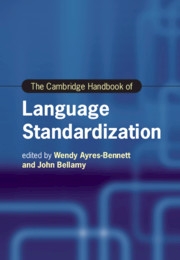Book contents
- The Cambridge Handbook of Language Standardization
- cambridge handbooks in language and linguistics
- The Cambridge Handbook of Language Standardization
- Copyright page
- Contents
- Figures
- Tables
- Contributors
- Introduction
- Part I Revisiting Models and Theories of Language Standardization
- Part II Legitimacy, Authority and the Written Form
- Part III Norms, Literacy and Education
- Part IV Beyond the National
- Part V Standardization in Late Modernity
- 25 Destandardization
- 26 Contemporary Perspectives on Language Standardization
- 27 Standardization and New Urban Vernaculars
- 28 Renegotiating Language Norms in Minority Contexts
- 29 Sign Language Standardization
- Name Index
- Subject Index
- References
29 - Sign Language Standardization
from Part V - Standardization in Late Modernity
Published online by Cambridge University Press: 01 July 2021
- The Cambridge Handbook of Language Standardization
- cambridge handbooks in language and linguistics
- The Cambridge Handbook of Language Standardization
- Copyright page
- Contents
- Figures
- Tables
- Contributors
- Introduction
- Part I Revisiting Models and Theories of Language Standardization
- Part II Legitimacy, Authority and the Written Form
- Part III Norms, Literacy and Education
- Part IV Beyond the National
- Part V Standardization in Late Modernity
- 25 Destandardization
- 26 Contemporary Perspectives on Language Standardization
- 27 Standardization and New Urban Vernaculars
- 28 Renegotiating Language Norms in Minority Contexts
- 29 Sign Language Standardization
- Name Index
- Subject Index
- References
Summary
This chapter addresses issues related to sign language standardization, a topic that has been approached from many different perspectives. To some members of the Deaf communities, language standardization represents a form of outsider oppression meant to ‘fill in gaps’ with the establishment of a ‘standard’ sign language that is ‘more consistent’. In this sense, there is a resistance in some Deaf communities against dictionaries or glossaries proposed for educational purposes or for teaching sign language. On the other hand, others in the Deaf communities discuss how to standardize their language(s) considering different motivations that are more inclusive, such as the recognition of the diverse varieties of a sign language and how to deal with them. These points are discussed considering the complex factors that are involved in the tentative language standardization processes of sign languages in many different countries. We present and discuss the different experiences and motivations of various language planning projects that include proposals of sign language standardization. We conclude that a successful language standardization process needs to include Deaf professionals as the protagonists.
Keywords
- Type
- Chapter
- Information
- The Cambridge Handbook of Language Standardization , pp. 765 - 788Publisher: Cambridge University PressPrint publication year: 2021



